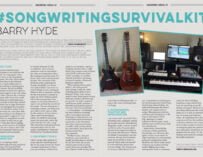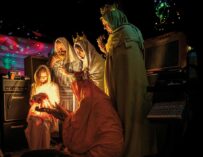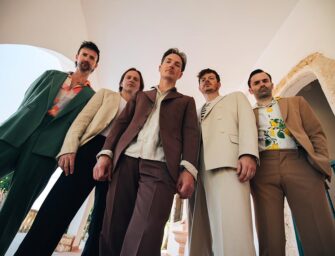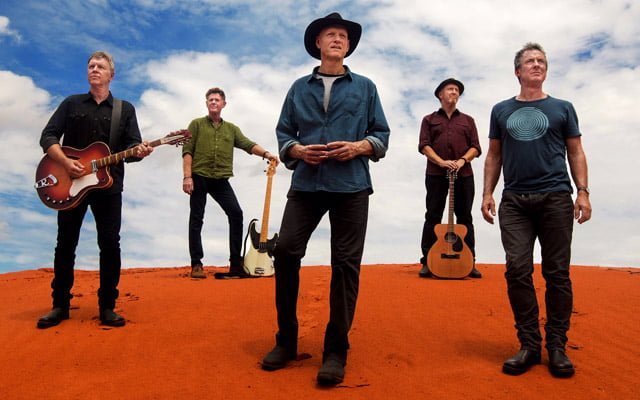
Barry Hyde: “Pretty quickly, I felt like I should go on a bit of a research mission to find some great lyrics from the annals of coalmining folk heritage.” Photo: Amelia Read
The Futureheads frontman on a personal and historic new solo album that explores the mining heritage of the North East
There are many reasons to write an album: a burning desire to release your songs out into the world, a concept that demands the scope of a full-length release, even contractual obligation. For Futureheads frontman Barry Hyde, however, his new solo album Miners’ Ballads began with a commission from Sunderland City Council and cultural director Paul Emerson. Charged with creating an album exploring the Northeast’s coal mining heritage, Hyde’s project quickly deepened. After discovering that two young ancestors were killed in the 1882 Trimdon Grange disaster, what began as a civic undertaking became a personal tribute to family and place.
Musically, Miners’ Ballads draws heavily from folk music, which should delight fans of his band’s album Rant. Offering a suite of songs both historical and emotionally grounded, traditional tracks like The Miner’s Life and Come All You Colliers channel the voice of the pitman with striking immediacy, while the striking Hyde original Last Dance (At the Landlord’s Ball) and What Happened To The Ponies bring drama, myth and tenderness to the subject without ever overshadowing the hardship and reality of life underground. Hyde’s storytelling is both meticulous and moving – a musical excavation of forgotten voices and enduring legacies.
Keen to learn more about the album’s creation, we recently caught up with Hyde…
Barry Hyde of The Futureheads’ Songwriting Survival Kit
Where did the initial idea for the album come from?
“This was a commissioned album, which is quite unusual, to be paid to make an album. Usually, it costs you to make an album. I started to do creative commissions up here in Sunderland many years ago. I’ve done all sorts of things, writing theme tunes to cultural campaigns, and the Futureheads were commissioned to write a choral work for the Lindisfarne Gospels. I’ve done loads of teaching in schools, workshops…
“I did a really fascinating one in Frankland prison, up here in Durham, and I was doing songwriting sessions with, amongst other people, a serial killer. I’ve been quite fortunate to be given these creative opportunities. This most recent one was to put together an album, the subject matter being the coalfields of the North of England, particularly the North East.
“It was pretty much a blank canvas; they gave me full creative freedom to put together some kind of album’s worth of material, and it was quite an interesting, revealing experience, especially with regards to parts of my personal ancestry.”
What were your first steps in terms of both diving into the history and turning it into song?
“I suppose the first question was, ‘Am I going to try and write some lyrics about coalmining? Am I going to think of this as a lyrical commission, or am I going to find lyrics?’ The Futureheads released an album in 2012 called Rant, and it contained some old North East folk songs like The Keeper, The Old Dun Cow, Hanging Johnny…
“Pretty quickly, I felt like I should go on a bit of a research mission to find some great lyrics from the annals of coalmining folk heritage and then use it as a compositional challenge to reimagine these songs with a kind of modern sensibility. Then it was a case of grafting them.
“When you put together a song collection, it’s about having a variety of tonalities, tempos, timbres, and all of these things make an album work. That’s a slow process. I had quite a bit of thinking time. I went out there and managed to find a few direct source materials, such as this fantastic book called Come All Ye Bold Miners – a song collection book put together by a folk historian called A. L. Lloyd. The range of topics was everything from union songs to songs of tragedy, humorous songs about antics in the public house after work…”
What happened next?
“That became a good, varied research resource for me to look into. I managed to find a few that I felt I could work with. Then, I ended up speaking to a good friend of mine, Keith Gregson, who’s a local historian and he’s also a songwriter. He gave me a huge insight that made this project far more fulfilling for me. Sometimes it’s difficult to get into a commission and to really make it a personal artistic project, because you’re creating art to order – you have to approach it like a carpenter where, you know, a table needs legs to put a top on, so you have to just kind of get on with it.
“Subsequently, sometimes the artistic depth doesn’t have time to develop. I always find it’s a mental process, making musical art. I like to record demos and listen to them intensely, obsessively, and after a while, it starts to emerge how you can make these things better. Or sometimes you just have to scrap them. I had one song, honestly, I was trying to write this song for six weeks, and in the end, I realised I just didn’t like it. There was something about it I couldn’t really penetrate.
“But anyway, Keith Gregson wrote a book of songs [Just One Man] with a retired coalminer called Jim Moreland and you can hear Jim Moreland actually speaking on a track called The Endless Ropes that was inspired by Gavin Bryars The Sinking Of The Titanic and Jesus’ Blood Never Failed Me Yet – a conceptual modern classical work that sampled a homeless man singing this sad little melody, that he looped endlessly and build into a huge orchestral arrangement. It’s amazing. I felt like having something like that, where you had a genuine artifact, was one way of giving the album a bit more historical gravitas, along with the lyrics that I’d found in these various books.”

Miners’ Ballads cover art. Barry Hyde: “I just love chords. I love scales and chords. I try not to repeat myself as a songwriter, but it’s difficult.”
And you also used some of those songs by Jim and Keith?
“Jim Moreland wrote some great songs with Keith, and a few of them are on the album. One is called What Happened To The Ponies? It’s such a sad song and an insight into the brutality of the subject matter. Before the mechanisation of the mines, the huge wagons that were full of coal were pulled by ponies. The ponies were only allowed out for like a day a year, so they were all blind because they were living in the darkness. These poor creatures were blind and they developed a sixth sense.
“There’s a story about this in on The Endless Ropes where one of his colleagues was trying to pull this pony, and the pony wouldn’t move. A few minutes later, part of the mineshaft collapsed, and the pony had this sixth sense that developed. But then, when they retired, they were sent off and turned into glue at a knacker’s yard. It was this industrialised attitude towards resources. With the unionisation of the mines, things improved for the miners but for the most part, miners were treated like slaves. If you ran away, you absconded from your responsibilities, and the coalmine owner would send people looking for you.”
Knowing that history, did that immediately give you an idea for how the music should sound?
“I just love chords. I love scales and chords. I try not to repeat myself as a songwriter, but it’s difficult. I fell into a trap recently, and I realised I had to do something about it, because I was basically using the same harmonic systems on every song. It’s called “The Cycle of Major Thirds.” I was like, ‘I can’t keep using the cycle of major thirds on every song,’ so I’ve tried to have a mixture of tonalities, moods, or modes, and try to use some elements of modulation. That’s how I gain enjoyment from composing, through trying to use tonalities express the feel.”
Will you always try and match lyrics with the feel of those tones or will you sometimes have chiming, bright chords against quite down lyrics?
“Indeed, and that’s what I call ‘upbeat melancholic’. Upbeat melancholic music is great, and I’m always trying for that, but I wanted to have a lot of different arrangement methods. I wanted some pieces that had quite broad arrangements, i.e., some kind of drums, electric guitars, a lot of harmonies. Then, for some of them, I wanted simple acoustic guitar, maybe a bit of bass guitar, just so that the album has a landscape to it that was going to be interesting. Arrangement is part of songwriting, but I would say the real challenge is getting the arrangements right and knowing when to stop.
“I used this experience as an opportunity to self-produce the album, mainly because of time. Not having to rely on anyone – someone else’s time, someone else’s diary – I can use my time more freely. I decided to take that upon myself. It was really challenging to line check a drum kit and then go and record it. After a while, I got my friend, a fantastic young songwriter called Tom A. Smith, to come in and do a bit of engineering.”
Was it nice that you were able to reflect your own family history and heritage at the same time?
“Definitely. I don’t know the exact statistics, but it’s probably fair to say that if you walk down a northern high street, a high percentage of the local people will have had heritage involving either coal mining or shipbuilding. This is how these cities emerged, through those industries. But when I found out that two of my ancestors, possibly more actually, but two definitely, perished in the 1882 Trimdon Grange explosion…. One of them was 12, and the other one was 14. Only a few of the bodies were brought out and put into a mass grave. There’s no graves for them – there’s a memorial in Trimdon.
“I wasn’t surprised that some of my ancestors had been involved in coalmining in some capacity, but it was the fact that they passed away in a terrible explosion, that’s why they were remembered. Because of my relationship with Keith Gregson, who was a historian who also gave me some of these great songs to look at… he’d already done a piece on my brother’s bloodline. Not only were there coal miners, but maybe more pertinent to us being musicians, on one side there were circus proprietors – literally a lion tamer and an equestrian master.”
What fascinating heritage…
“It’s kind of strange, but Keith thought it was fascinating because me and me brother [Dave Hyde, The Futureheads’ drummer] are performers. It’s in the blood or something like that. He also found a little bit about the Trimdon Grange explosion back then, but then he looked into it further, found out names and stuff like that. It felt to me like I’d kind of lucked out in a sense. What was quite a difficult creative project to get into creatively, to kind of to get the ball rolling…
“Writing an album is not an easy task, no matter what the context is. It’s a difficult task, it requires many hundreds of hours. Therefore, writing an album that maybe wasn’t through a creative personal choice, what could have been an agonising experience, suddenly it became more of a personal project.”

Barry Hyde: “I’m endlessly learning from studying Bach. I just wish I was good enough to play his compositions properly.” Photo: Amelia Read
How did that impact things?
“I really struggled recording the last song on the album. It is an acapella version of a song called Trimdon Grange Explosion by Tommy Armstrong, ‘The Pitman Poet’ he was called. He did this fantastic lyric. It was recorded a lot, actually, and most famously by Alan Price from The Animals – he had a big hit it back in the late ‘60s, I think. I struggled to record. I couldn’t actually get the lyric recorded because I felt extremely emotional about it.
“I don’t have any personal experiential knowledge of mining, but the topic of mining was a fascinating subject, culturally, and the community around the coalfields and the colliery bands, the workingmen’s clubs, the tight-knit communities – it was a beautiful thing. It’s an example of how beautiful things come from things that aren’t beautiful, like not knowing if your husband or sons are going to come home from work tonight, every single time they went to work. Reality must have been awful, and when something did happen, the community would come together to make sure that these poor families that had been left behind weren’t left behind, literally. They’d kind support each other. We do see that type of thing these days, but it’s quite rare.”
When it came to putting the tracklist together, were you looking for an overarching story?
“I was just trying to have different subject matter. There are emotional songs – union songs like Come All You Colliers, which I released the other day. There are tracks on the album that are about everyday life, for example, Putter’s Lament and The Miner’s Life. Once I put the collection together, I realised I was a bit short of songs, so I added a few extra ones, such as The Endless Ropes and another one called Working Man, which is actually an American mining song.
“Then I realised there was some kind of storyline around the landlord trying to woo a local colliery girl, and she’s in love with a miner. I started to dream about making this into a musical. There was a not-quite-finished storyline, but something to build around. So a project I’m doing is trying to realise that, build around it; not just take the album and put people on stage singing it, but use it as a starting point to make a modern musical theatre piece about a terrible coalmining tragedy.”
Did you write any of the lyrics?
“I wrote lyrics on one song, Last Dance (At The Landlord’s Ball). That one was a composition I had kicking around for a while. I tried to get the Futureheads to record it, but it was a bit too old-fashioned. I spent a long time arranging that song with the chords. It uses three keys; I like doing modulations that you don’t really notice, not those blunt modulations where you suddenly just go up a semitone or something like that.
“I like to use the cycle of fourths and fifths, because I’m very influenced by Johann Sebastian Bach. The Miner’s Life, the first track on the album, is based loosely around the harmonic structure of the Cello Suite In G. [Cello Suite No.1 In G Major]. On my solo album Malody, I took the Prelude In C [Prelude And Fugue In C Major] and made it into a song – without the arpeggiation, but essentially the chord template. I did have to make it more ‘song-y’, because Bach’s pieces, especially as preludes and suites, keep growing and evolving and moving around and coming back. I kind of sussed it out and then added a few extra chords to make it work in a practical sense for a song.”
You took Bach and made it your own…
“I’m endlessly learning from studying Bach. I just wish I was good enough to play his compositions properly. But for the most part, I’m not. I’m a self-taught piano player. I used to work in a primary school as a music teacher, and the head teacher could sight-read Bach fugues. It just seemed superhuman, I couldn’t do it. I wish I started playing piano more seriously at a younger age, because I might be able to actually sit and just listen to Bach as I’m playing it, but I have to sit with the papers and try and suss out what he’s doing.”
And is that a fascination with structure and chord and scales something that’s just developed or something that you’ve always had?
“I think, for a so-called indie musician, I’m probably quite developed. I did a B.Tech in music when I was a teenager, and I was always interested in modes and scales. I’ve always loved some classical music and jazz. But it wasn’t really until I became a teacher of music, when the band took a hiatus, I guess in around 2013… We had a five-year hiatus, and during that time, I became a lecturer in music. I did a degree, a BA, then a master’s degree, and I ended up doing a lot of teaching.
“Through doing a masters and a BA, I learned how to write music out, do orchestral scores. That was actually the most powerful thing ever, to learn how to write music out. I’m not a great sight-reader. When we hear music, we can feel the structure of it, but when we see it written down, we can see the structure of it: we can see weak intervals, we can see strong intervals, we can see dynamics.
“It was a revelation for me to actually to understand perfect fifths and the harmonic series and modulations. It was a different way, because I’d already released lots of albums and written lots of songs and had them published, but it was kind of like, ‘Right there’s this tradition that comes from classical music and folk music. These ideas are important to know and be able to use.’”
Did you bring them into the band when you made Powers?
“One hundred percent. There’s a song on Powers, right, called Animus – it’s in seven keys, and I think it’s got 45 chords. I’ve tried to write a Buzzcocks-style song which moves through key signatures, but you don’t really know. I was trying to slip in the European philosophies of music without anyone knowing, but what it means is that we can’t really play them. We don’t do that many gigs, it’s not like we’re on the road all the time. We have to get match fit, so, to throw in songs using the whole tone scale, or using music theory concepts, we don’t have the time. But we still record them.”
Is there an expectation that this is a project that you were asked to do, that you were paid money to do? Does that mean that it comes with kind of conditions of what they want it to achieve?
“I think it was mainly to do with becoming some kind of heritage document. It was the third commission I’d done via the council, and obviously, because I delivered on the other ones, it was kind of open, but the condition was that the album comes out. It is coming out, and we’re getting press for it. Also, I’ll do a couple of gigs up here and, whenever I can, talk about the commission. I’ll gift the council a load of copies of the album, which they can put in the local museum for sale – the mining museum in Washington called the F Pit.”


































Related Articles